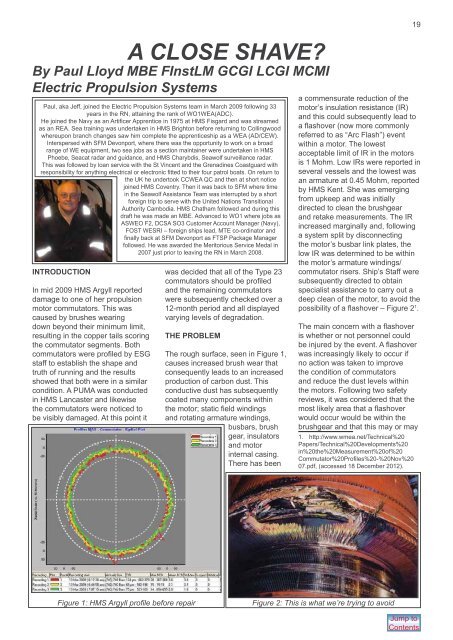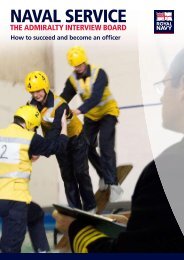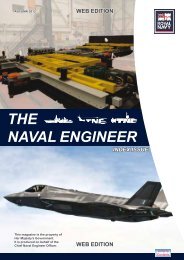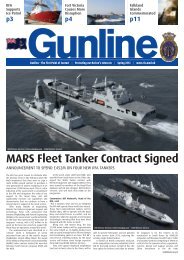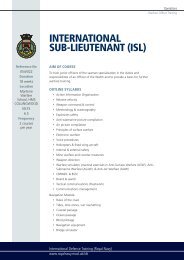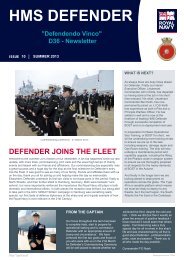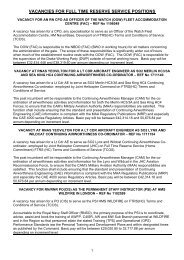THE NAVAL ENGINEER
THE NAVAL ENGINEER
THE NAVAL ENGINEER
Create successful ePaper yourself
Turn your PDF publications into a flip-book with our unique Google optimized e-Paper software.
A Close Shave?<br />
By Paul Lloyd MBE FInstLM GCGI LCGI MCMI<br />
Electric Propulsion Systems<br />
Paul, aka Jeff, joined the Electric Propulsion Systems team in March 2009 following 33<br />
years in the RN, attaining the rank of WO1WEA(ADC).<br />
He joined the Navy as an Artificer Apprentice in 1975 at HMS Fisgard and was streamed<br />
as an REA. Sea training was undertaken in HMS Brighton before returning to Collingwood<br />
whereupon branch changes saw him complete the apprenticeship as a WEA (AD/CEW).<br />
Interspersed with SFM Devonport, where there was the opportunity to work on a broad<br />
range of WE equipment, two sea jobs as a section maintainer were undertaken in HMS<br />
Phoebe, Seacat radar and guidance, and HMS Charybdis, Seawolf surveillance radar.<br />
This was followed by loan service with the St Vincent and the Grenadines Coastguard with<br />
responsibility for anything electrical or electronic fitted to their four patrol boats. On return to<br />
the UK he undertook CCWEA QC and then at short notice<br />
joined HMS Coventry. Then it was back to SFM where time<br />
in the Seawolf Assistance Team was interrupted by a short<br />
foreign trip to serve with the United Nations Transitional<br />
Authority Cambodia. HMS Chatham followed and during this<br />
draft he was made an MBE. Advanced to WO1 where jobs as<br />
ASWEO F2, DCSA SO3 Customer Account Manager (Navy),<br />
FOST WESRI – foreign ships lead, MTE co-ordinator and<br />
finally back at SFM Devonport as FTSP Package Manager<br />
followed. He was awarded the Meritorious Service Medal in<br />
2007 just prior to leaving the RN in March 2008.<br />
Introduction<br />
In mid 2009 HMS Argyll reported<br />
damage to one of her propulsion<br />
motor commutators. This was<br />
caused by brushes wearing<br />
down beyond their minimum limit,<br />
resulting in the copper tails scoring<br />
the commutator segments. Both<br />
commutators were profiled by ESG<br />
staff to establish the shape and<br />
truth of running and the results<br />
showed that both were in a similar<br />
condition. A PUMA was conducted<br />
in HMS Lancaster and likewise<br />
the commutators were noticed to<br />
be visibly damaged. At this point it<br />
was decided that all of the Type 23<br />
commutators should be profiled<br />
and the remaining commutators<br />
were subsequently checked over a<br />
12-month period and all displayed<br />
varying levels of degradation.<br />
The problem<br />
The rough surface, seen in Figure 1,<br />
causes increased brush wear that<br />
consequently leads to an increased<br />
production of carbon dust. This<br />
conductive dust has subsequently<br />
coated many components within<br />
the motor; static field windings<br />
and rotating armature windings,<br />
busbars, brush<br />
gear, insulators<br />
and motor<br />
internal casing.<br />
There has been<br />
19<br />
a commensurate reduction of the<br />
motor’s insulation resistance (IR)<br />
and this could subsequently lead to<br />
a flashover (now more commonly<br />
referred to as “Arc Flash”) event<br />
within a motor. The lowest<br />
acceptable limit of IR in the motors<br />
is 1 Mohm. Low IRs were reported in<br />
several vessels and the lowest was<br />
an armature at 0.45 Mohm, reported<br />
by HMS Kent. She was emerging<br />
from upkeep and was initially<br />
directed to clean the brushgear<br />
and retake measurements. The IR<br />
increased marginally and, following<br />
a system split by disconnecting<br />
the motor’s busbar link plates, the<br />
low IR was determined to be within<br />
the motor’s armature windings/<br />
commutator risers. Ship’s Staff were<br />
subsequently directed to obtain<br />
specialist assistance to carry out a<br />
deep clean of the motor, to avoid the<br />
possibility of a flashover – Figure 2 1 .<br />
The main concern with a flashover<br />
is whether or not personnel could<br />
be injured by the event. A flashover<br />
was increasingly likely to occur if<br />
no action was taken to improve<br />
the condition of commutators<br />
and reduce the dust levels within<br />
the motors. Following two safety<br />
reviews, it was considered that the<br />
most likely area that a flashover<br />
would occur would be within the<br />
brushgear and that this may or may<br />
1. http://www.wmea.net/Technical%20<br />
Papers/Technical%20Developments%20<br />
in%20the%20Measurement%20of%20<br />
Commutator%20Profiles%20-%20Nov%20<br />
07.pdf, (accessed 18 December 2012).<br />
Figure 1: HMS Argyll profile before repair<br />
Figure 2: This is what we’re trying to avoid<br />
Jump to<br />
Contents


